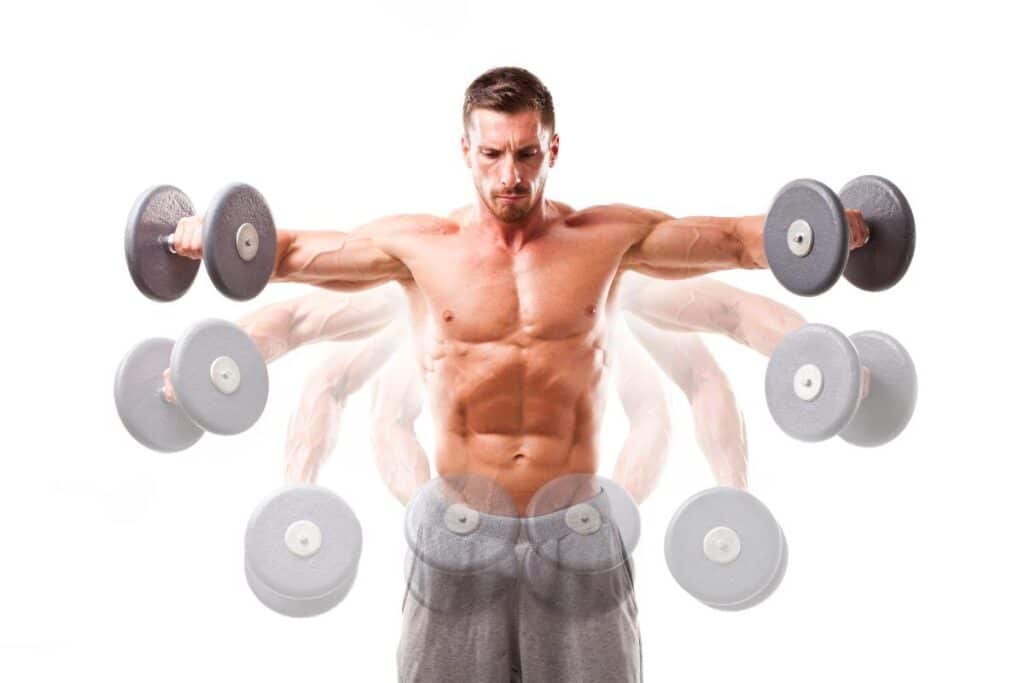The quest for muscle growth is a marathon, not a sprint, and every exercise you incorporate into your routine plays a crucial role. Lateral raises, commonly known as ‘lat raises,’ are a fundamental part of this journey, specifically targeting the deltoid muscles in the shoulders. With the focus key phrase “lat raises,” we’ll explore how this exercise can be a cornerstone in your muscle-building odyssey. In addition we provide videos on how to correctly perform the lat raise to build posterior shoulder and back muscles.
Unlocking the Potential of Lat Raises
Lat raises are not just another item on your workout checklist; they are a strategic move to enhance muscle symmetry and strength. By isolating the lateral aspect of the deltoid muscles, they contribute significantly to the broad, sought-after “V” shape of the upper body, which is a hallmark of strength and fitness.
Key Benefits:
- Shoulder Sculpting: Lat raises are exceptional for carving out the deltoid muscles.
- Improved Shoulder Health: They help in balancing the rotator cuff muscles for better joint health.
- Versatility: Lat raises can be performed with dumbbells, cables, or resistance bands, making them accessible to all fitness levels.

muscles lat raises develop and how it affects overall back develop
Lat raises primarily target the lateral deltoids, which are the muscles on the outer aspect of the shoulders. While the exercise is not focused on the back itself, the development of the lateral deltoids has a significant impact on overall back aesthetics and function. Strong lateral deltoids enhance the shoulder’s width and definition, contributing to a broader, more V-shaped torso when viewed from behind, which can make the waist appear narrower and create a more balanced physique.
Additionally, lat raises indirectly work the upper back muscles, including the supraspinatus, part of the rotator cuff, and the trapezius, which assists during the lifting phase of the movement. By strengthening these muscles, lat raises contribute to better posture and shoulder stability, which are essential for the effective performance of compound back exercises like rows and pull-ups. In this way, lat raises not only develop the shoulder muscles but also support comprehensive back development by ensuring the shoulder joints are well stabilized and the upper back muscles are engaged, facilitating a stronger, more well-rounded upper body.
important to develop back and shoulder muscles
Developing back and shoulder muscles is critical for both functional strength and overall physical health. The back muscles support the spine and are fundamental to posture. Strong back muscles help to prevent the common occurrence of back pain and injuries, which can result from weak musculature and poor structural support. Moreover, a robust back allows for greater strength and efficiency in pulling, lifting, and carrying movements, which are essential in daily activities and various sports.
Shoulders, being integral to the upper body’s range of motion, are pivotal for performing an array of actions from pushing to lifting. Well-developed shoulder muscles contribute to the stability of the shoulder joints, reducing the risk of injuries and wear over time.
Additionally, aesthetically, strong back and shoulder muscles contribute to a well-proportioned and balanced physique, often enhancing physical appearance with a broadened upper body silhouette. In essence, training these areas is not only beneficial for enhancing athletic performance and day-to-day functionality but also for maintaining long-term musculoskeletal health.
steps to perform lat raises and the mistakes to avoid
Steps
To perform lat raises correctly, begin by standing with your feet shoulder-width apart, knees slightly bent for stability. Grip a dumbbell in each hand with a neutral grip, palms facing inwards, and let them hang at your sides. Brace your core and lift the weights out to the sides, keeping your arms almost straight, with a slight bend at the elbows to avoid joint strain. Elevate the weights until your arms are parallel to the floor, then control the descent back to the starting position.
mistakes
Common mistakes to avoid include using momentum to swing the weights up (which reduces muscle engagement), lifting the dumbbells too high (which can stress the shoulder joints), and arching the back during the lift (which can cause lower back pain).
Frequency
As for frequency and muscle-building timeline, lat raises should be incorporated into your shoulder routine 2-3 times per week, allowing for adequate recovery between sessions. Consistency and progressive overload are key; as you grow stronger, gradually increase the weight or the number of repetitions.
Muscle Hypertrophy
Generally, noticeable muscle hypertrophy requires consistent training for several weeks to months. Most individuals can expect to see changes in muscle definition within 6-8 weeks of regular, targeted training like lat raises, with significant increases in strength and muscle size potentially taking several months or more, depending on individual fitness levels, diet, and overall training intensity.
Incorporating Lat Raises into Your Muscle Growth Journey
To truly benefit from lat raises, they should be integrated thoughtfully into your workout regimen:
1. Form First: Begin with a lighter weight to master the technique, ensuring you’re engaging the correct muscles without swaying or using momentum.
2. Progressive Overload: Gradually increase the weight or reps to continuously challenge your muscles.
3. Consistency is Key: Regularly including lat raises in your routine will lead to optimal muscle growth and development.
Lat Raises Within a Workout Routine
Here’s an example of how lat raises can fit into a broader shoulder workout:
1. Warm-Up: Start with arm circles and light stretching to prepare your shoulder joints.
2. Compound Movement (e.g., Overhead Press): 4 sets of 8-10 reps
3. Lat Raises: 3 sets of 12-15 reps
4. Front Raises: 3 sets of 12-15 reps to target the anterior deltoids.
5. Rear Delt Flyes: 3 sets of 12-15 reps to hit the posterior deltoids for a balanced shoulder development.
6. Cooldown: Finish with stretching to promote recovery and flexibility.
Conclusion
Lat raises are more than just an exercise; they’re a journey into aesthetic and functional muscle growth. By incorporating lat raises into your fitness regime, you’re not only working towards well-defined shoulders but also ensuring a balanced upper body development. Let each raise be a step forward in your muscle growth journey, bringing you closer to your strength and physique goals.





Excellent information was provided. I truly liked reading this piece, and I’m grateful to the author for providing it. Thank you for sharing this blog post. Once again, thanks. Nice.